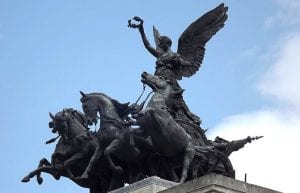Ever since I was a child, I have loved learning about Greek and Roman mythology. I loved the Disney movie Hercules and devoured books like the ‘Percy Jackson and the Olympians’ series by Rick Riordan. In addition, I felt strong connections with many of the various gods and goddesses. For example, my favorite goddess was Artemis (Diana in Roman mythology), simply and solely for the fact she is a twin with the god Apollo. Like Artemis, I have a twin brother. It was rare for me as a child to hear of other boy-girl twins in stories, so I developed a strong fascination with Artemis. I looked for signs of her everywhere in books, artwork, and movie characters. Sadly, as I grew older I stopped looking for signs of Artemis or of any of the other Greek or Roman gods. Having no opportunity to take a class on it in school, I also drifted away from the field of mythology in general. Besides knowing the bare basics about the most popular myths and characters, I knew almost nothing about mythology.
Luckily for me, a study abroad opportunity presented itself to me and I jumped at the chance to learn about Greek and Roman mythology in London. Now, I get the chance to rediscover and fall in love with mythology all over again. And after my time in London and the mythology course, I’m noticing mythological symbols everywhere! From subtle to glaringly obvious, there are references to Greek and Roman mythology all around London. So, I decided to pick a day where I already had plans and see how many links to mythology I could find while I went about my day. The day I chose happened to be the day I toured the Harry Potter studio at Warner Bros. I picked this day because I assumed, naively, that I would not be able to find that many references to Greek and Roman mythology during the tour or on the trip to and from the studios. There were in fact so many connections to Greek and Roman mythology that I am only going to mention a few of the obvious links I saw and I am going to exclude any links I found in the material of the Harry Potter books I noticed while on my tour of the studio.
The first link I found to Greek and Roman mythology was when I was walking around before the tour began. Across the street from the tour building was Hermes London Dental Clinic (picture taken from my phone):
The obvious reference is to the Greek god Hermes (Mercury in Roman mythology). Hermes is most commonly known as the god of messengers (“Greek Gods and Goddesses”). One of his most popular symbols is the caduceus (kerykeion in Greek) – the rod with two entwined snakes and wings at the top of the rod (“Caduceus”)
HOT NECESSARY THAT YOU REPEA “Caduceus”, AS YOU HAVE MENTIONED ITS NAME ALREADY TWO LINES ABOVE. IF YOU MENTION IT AGAIN, IT SEEMS THAT YOU HAVE FORGOTTEN YOU QUOTED IT ALREADY.
. What is interesting to me is that Hermes and his rod are associated with dentistry at all. Perhaps the connection to Hermes is a mistake as his rod is often mistaken for the staff of Asclepius, who is known as a healer (“Caduceus”). Or perhaps the dental clinic used him for advertising – believing more people would recognize the name of Hermes and not worry about the inaccuracy of associating him or his rod with healing. Whatever the case may be, the name indicates an interest in mythology in London that continues to this day.
The second connection I found to Greek and Roman mythology was at the Harry Potter tour itself. While walking along a path covered by a tent-like roof, I looked up and happened to see this logo (picture taken from my phone):
The name and symbol are clearly a reference to Poseidon (Neptune in Roman mythology). The long beard, trident, and wave he seems to be leaning on are all symbols associated with Poseidon (“Greek Gods and Goddesses”). Again, the reason for naming a company that supplies tent-like roofs after the god of the sea is unclear. My interpretation would be that the company wanted to invoke a familiar image with many people in order to better advertise their product. Or maybe the company wanted to indicate their purpose in keeping people out of the water by associating themselves with one of the most iconic symbols of water. As with the Hermes dental company, the link to mythology seems to be for advertising purposes rather than as a means of honoring the gods.
THE LAST STATEMENT IS A BIT NAIVE … WHO DOES STILL HONOUR THE GODS OF MYTHOLOGY IN MODERN TIMES?
The final connection I noticed was the enormous statue of Nike (Victoria in Roman mythology) at the Wellington Arch. Nike is known as the goddess of victory in war or peace (“Greek Gods and Goddesses”). The statue is clearly of Nike due to her wings and wreath in one hand – both are traditional symbols for Nike (“Greek Gods and Goddesses”). The connection to Nike is even more obvious after researching why the arch and statue were built: the arch was made for the British victory in the Napoleonic Wars and the statue (shown below from “Nike Today”) was later added to further emphasize the victory (Green).

The purpose of the link to Nike is not vague or subtle in this case. Britain very clearly wanted to emphasize and celebrate its victory in war and so included the widely-known figure of Nike in a giant statue for everyone to see.
These three examples of modern references to Greek and Roman mythology are just a tiny fraction of the overall number of connections to mythology in London. Regardless of the purpose for making these links, they serve as a reminder of how deeply mythology still permeates modern societies. Why are there still so many signs of the ancient gods and goddesses in London? I’m not sure. Perhaps the mythological stories are simply endearing to the people that hear them and thus they want to honor this love by naming things after the gods. Maybe the gods are merely a good advertising technique and way to easily convey an artist’s or business’ intentions. Or maybe artists and designers just become lazy after a while and don’t want to brainstorm a unique name or design. I for one am quite happy no matter the reason for the numerous modern references to Greek and Roman mythology in London and throughout the world. These references give me the opportunity to search for my favorite gods and goddesses in the world around me and enjoy mythology once more.
Bibliography
“Caduceus.” Encyclopædia Britannica, Encyclopædia Britannica, Inc., 9 Feb. 2018,
www.britannica.com/topic/caduceus
“Greek Gods and Goddesses.” Theoi Greek Mythology, Theoi Project, 2017,
www.theoi.com/greek-mythology/greek-gods.html
Green, David. Wellington Arch. VIPA, http://vipauk.org/enter/muse/lond/w03.html
“Nike Today.” About Nike, Nike Is Now, 2017,

